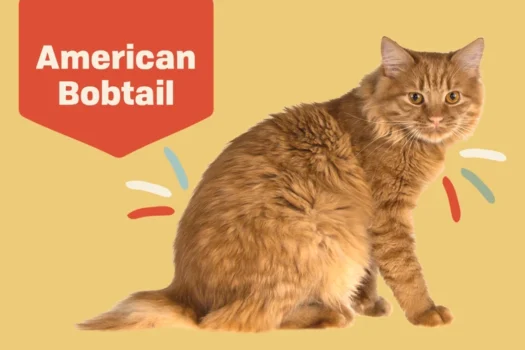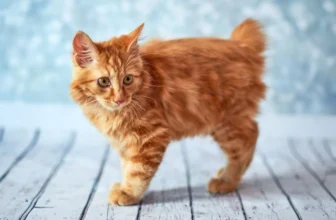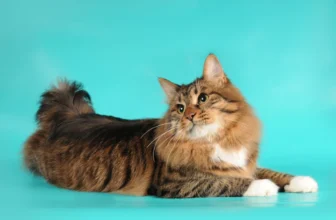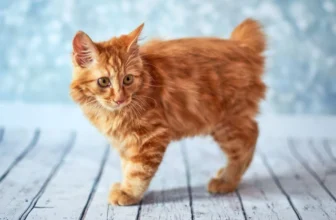It’s a bizarre sight to see a cat with a short, stumpy tail. You might even wonder if it’s a genetic mutation or a result of injury. However, for American Bobtails, this short tail is a defining characteristic of the breed. Have you ever wondered why these cats have such a unique feature? Well, wonder no more, because we’re going to take an in-depth look at the fascinating history, genetics, physical characteristics, and care of American Bobtails with short tails. Get ready to explore the world of bobtail cats like never before!
The History of American Bobtails
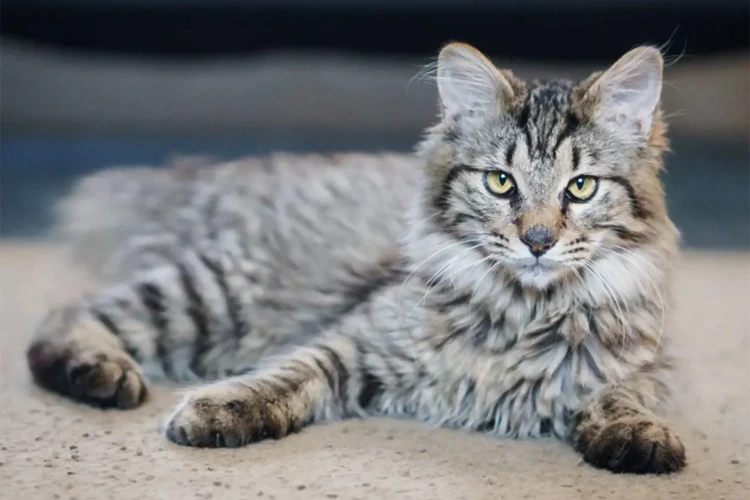
The origins of the American Bobtail are shrouded in mystery and intrigue, but one thing is clear: these cats have captured the hearts of many with their unique appearance and lovable personalities. According to historical records, the American Bobtail breed originated in the 1960s when a short-tailed brown tabby kitten was discovered in an alley in Arizona. This kitten was bred with a Siamese cat, and thus the American Bobtail breed was born. While their exact origins may be unknown, their distinctive features are what set them apart from other cats. From their muscular build to their striking eyes, American Bobtails are truly a breed like no other. To learn more about their fascinating history, continue reading. And if you want to know about their muscular build, follow the link to /american-bobtail-muscular-build/.
Breeding and Development
Breeding and Development:
The American Bobtail breed started to develop in the 1960s when an American couple, John and Brenda Sanders, discovered a short-tailed tabby cat roaming around an Arizona Indian reservation. They named her Yodi and decided to adopt her, as they found her to be an exceptionally intelligent cat with a friendly disposition. Soon after, Yodi had a litter of kittens, some of which also had bobtails. The Sanderses became intrigued by this unique trait and started a breeding program, using selective breeding to create a consistent type.
They used domestic cats with recognized breeds, such as the Siamese and the Himalayan, to crossbreed with the bobtailed cats, which helped diversify the gene pool and create a healthy breed. The cats were also crossbred with feral cats to introduce genetic diversity and vigor.
One of the distinct features of the American Bobtail breed is its powerful legs, which allow them to jump and climb with ease. The breed also possesses unique coat patterns, making each cat a work of art with its own individual style. In addition to their bobbed tails, some American Bobtails also have polydactyl paws, which have extra toes that make them look like they are wearing oversized mittens.
Throughout the years, breeders have focused on producing healthier and more robust American Bobtails. They have also bred cats with a variety of coat colors and patterns in order to expand the breed’s diversity. Today, American Bobtails are recognized by cat associations worldwide and cherished for their friendly and sociable personalities, striking eyes, and unique body shape, which also contributes to their excellent overall health.
Early Recognitions
During the 1960s, the American Bobtail started to gain recognition as a separate breed. It began with John and Brenda Sanders, a couple from Iowa who discovered a short-tailed kitten on a Native American reservation in Arizona. The couple took the kitten home with them and bred it with a Siamese cat, which resulted in a litter of kittens with short tails.
The first recognition of American Bobtails as a distinct breed came from the International Cat Association (TICA) in 1989. The association officially recognized the breed and established a breed standard that included specific physical characteristics, such as a short tail, a sturdy body shape, and almond-shaped eyes.
In 2000, the Cat Fanciers’ Association (CFA) also recognized the American Bobtail as a separate breed. The CFA has slightly different breed standards than TICA and focuses more on the cat’s body shape, size, and coat pattern.
In recent years, the American Bobtail has gained popularity among cat enthusiasts, and many breeders now specialize in breeding and showing these cats.
It’s important to note that although the American Bobtail is generally a healthy breed, they can be prone to certain health issues related to their body shape, such as hip dysplasia and spinal problems. To ensure your American Bobtail stays healthy, it’s crucial to keep up with regular vet visits and provide them with a well-balanced diet and exercise.
The American Bobtail has a fascinating history, from its origins on a Native American reservation to its recognition as a distinct breed by multiple cat associations. Despite their short tails and unique body shape, these cats make fantastic pets for families and individuals alike. Don’t forget to check out our article about body shape and health of American Bobtails for more information on how to care for this wonderful breed.
The Genetics Behind the Bobtail
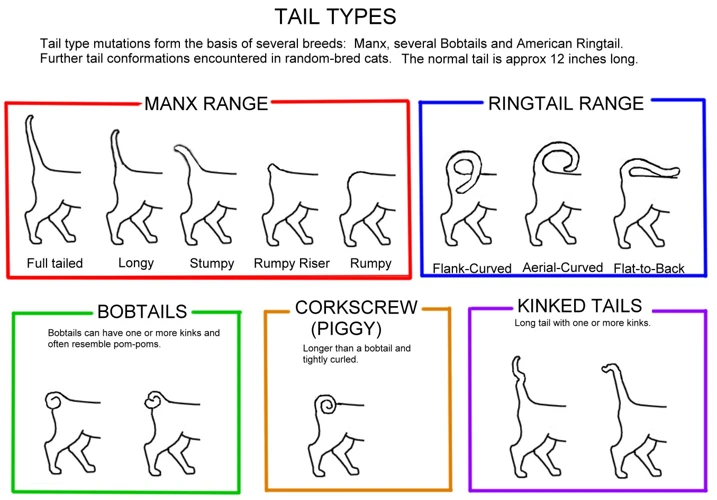
The mystery of American Bobtails’ short tails has puzzled cat lovers and researchers for centuries. Despite numerous scientific studies, the genetics behind the bobtail gene remain a subject of interest to many. With the help of modern technology, scientists have made progress in unlocking the mystery behind the bobtail, revealing some surprising discoveries about the genetics and other factors affecting the tail length of these unique felines. In this section, we delve into the intricacies of the genetics behind the bobtail, uncovering fascinating details that shed light on these beloved cats.
The Bobtail Gene
One of the most interesting features of American Bobtails is undoubtedly their short tails. This unique trait is due to a genetic mutation known as the “bobtail gene.” Here are some key facts about this gene:
- It’s a dominant gene: This means that if a cat inherits the bobtail gene from just one parent, it will have a short tail. In other words, only one copy of the gene is necessary to produce the bobtail trait.
- It’s not specific to American Bobtails: While American Bobtails are perhaps the best-known breed with this trait, the bobtail gene can be found in other cat breeds as well. Some examples include the Japanese Bobtail, the Kurilian Bobtail, and the Manx.
- It can have different levels of expression: Not all cats with the bobtail gene have tails of exactly the same length. Some may have shorter tails than others, while still others may have tails that are slightly longer but still shorter than those of a typical cat.
- It can cause other physical characteristics: In addition to the shortened tail, the bobtail gene can also lead to some other unique physical traits. For example, American Bobtails with the gene are often more muscular and have larger front paws than other cats.
- It can cause health problems: While the bobtail gene itself is not harmful, it can be associated with some health issues. For example, some cats with the gene may experience spinal problems or difficulty controlling their bowel movements.
Despite possible health risks associated with the bobtail gene, it has become a popular feature in certain cat breeds, with many people finding the shortened tail cute or endearing. As a result, breeders have continued to selectively breed cats with the gene in order to produce more bobtailed kittens. However, it’s important to remember that responsible breeding practices should always prioritize the health of the cats involved.
Other Factors Affecting Tail Length
There are several factors that can affect the length of a cat’s tail, in addition to the presence of the bobtail gene. Below is a table outlining some of these factors:
| Factor | Possible Effect on Tail Length |
|---|---|
| Gender | Male cats tend to have longer tails than females. |
| Breed | Certain breeds, such as the Siamese or Himalayan, are known for having longer tails. |
| Age | Kittens are born with short tails that continue to grow until they reach adulthood. |
| Injury | A traumatic injury to the tail can cause it to become shorter or even amputated. |
| Illness | Certain illnesses or conditions, such as hyperthyroidism, can cause hair loss on the tail, making it appear shorter. |
It’s important to note that while these factors can contribute to tail length, the presence of the bobtail gene is still the primary determinant in the length of a cat’s tail. Additionally, not all American Bobtails have short tails, as there can be variation within the breed due to factors such as genetics and breeding practices.
Physical Characteristics of American Bobtails
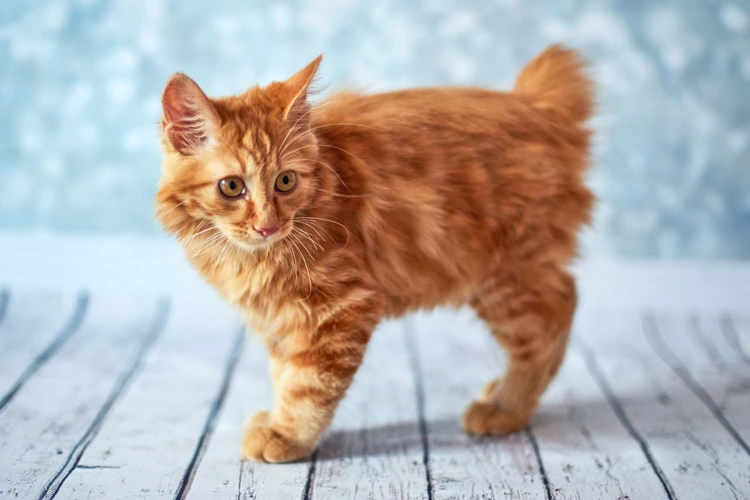
When it comes to physical characteristics, American Bobtails stand out from other cat breeds in many ways. Their short, stubby tails make them instantly recognizable, but there’s much more to this unique feline than just their tail. From their muscular build to their distinctive coat patterns, American Bobtails are truly one-of-a-kind. In this section, we’ll take a closer look at the physical features that set American Bobtails apart from the rest. So, grab a cup of coffee and read on to discover what makes American Bobtails such a fascinating breed.
The Short Tail and Its Adaptations
The American Bobtail is known for its distinctly short tail, which is a defining characteristic of the breed. But what purpose does this short tail serve, and how has it adapted over time? Let’s take a closer look:
The Origins of the Bobtail
The shortened tail of the American Bobtail is thought to have originated from a natural genetic mutation. This mutation likely occurred in a population of domestic cats in North America and was eventually bred selectively to produce a distinct breed.
The Adaptations of the Short Tail
Despite the unusual appearance of their tails, American Bobtails are highly adaptable and have evolved unique abilities to compensate for their shortness. Some of the key adaptations of the short tail include:
| Adaptation | Description |
| Improved Balance | Veterinarians have observed that American Bobtails have an exceptional sense of balance – even better than many other cat breeds – which is likely due in part to their short tails. Without the added weight and length of a traditional feline tail, Bobtails are more nimble and able to land on their feet more easily when they fall. |
| Enhanced Hunting Skills | In the wild, a long tail can be a liability for a hunting predator, as it can be detected by prey and used as a means of escape. American Bobtails have adapted to this by learning to use their body language and other physical cues to communicate without the need for a long tail that could be an easy target for prey. |
| Superior Jumping Ability | American Bobtails are known for their impressive jumping ability, which is partly due to their short, muscular tails. With a shorter tail, these cats are able to propel themselves higher and farther when jumping, giving them an advantage over other cat breeds. |
The short tail of the American Bobtail is not just an unusual physical characteristic – it is a key adaptation that has helped this breed thrive and adapt to its environment. While the breed may look a bit unusual to some, its unique characteristics make it a fascinating and popular choice for cat lovers around the world.
Other Features That Make American Bobtails Unique
American Bobtails are not only known for their distinctive short tails, but also for other unique physical features that set them apart from other cat breeds. These features include:
- Muscular Build: American Bobtails have a muscular physique and a sturdy, compact build that makes them agile hunters.
- Fur and Coat: Their fur is thick, shaggy, and usually in a tabby pattern. They also have a variety of coat colors, from traditional browns and blacks to less common blues and reds.
- Paw Size: American Bobtails have large, round paws with extra fur padding that make them ideal for walking on all kinds of terrain, including snow and rough terrain.
- Facial Features: These cats have a strong, square jaw, wide-set ears, and expressive oval-shaped eyes. Their faces give them a friendly and slightly wild look that’s quite irresistible.
- Social Personality: American Bobtails are known for their friendly, sociable personalities. They are often described as playful, loyal, and highly adaptable to new environments.
In addition to these physical characteristics, American Bobtails are also unique in their vocalizations. They tend to make chirping or trilling sounds rather than meows, which is another trait that sets them apart from other cat breeds. American Bobtails are a highly unique and captivating breed that cat lovers are sure to adore.
Short Tailed Cats Around the World
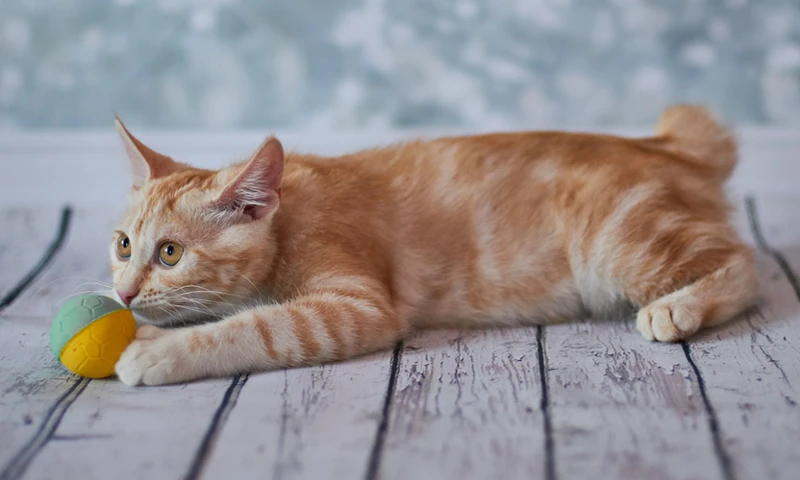
As fascinating as the American Bobtail’s short tail is, they are not the only cats in the world with this unique characteristic. Short-tailed cats can be found all across the globe, and some of them have even become breeds of their own. From the Japanese Bobtail to the Manx cat, each short-tailed breed has its own history and traits that make them stand out. Let’s explore the world of short-tailed cats and discover some interesting facts about them.
Similar Breeds to American Bobtails
American Bobtails are a unique breed with their distinct short tails and wild appearance. However, there are a few other breeds that share some similarities with American Bobtails. Let’s take a closer look at those breeds in the table below.
| Breed | Description |
|---|---|
| Japanese Bobtail | A breed of domestic cat with a short, bobtail that is the result of a genetic mutation. |
| Kurilian Bobtail | A natural breed of cat from the Kuril Islands, Russia with a distinct bobbed tail. |
| Manx | A breed of domestic cat with a naturally occurring mutation that results in a tailless or partially tailed appearance. |
| Pixie-Bob | A breed of domestic cat developed to resemble the North American Bobcat, with a short, bobbed tail. |
| Ashera | A hybrid breed of cat with a bobbed tail, bred from a mix of Domestic, Asian Leopard, and African Serval cats. |
While these breeds share some physical similarities with American Bobtails, each has their unique characteristics that make them stand out. The Japanese Bobtail, for example, has a distinct appearance due to the shape of its tail. The Kurilian Bobtail has a wild appearance, similar to American Bobtails, due to their large size and thick coat. Manx cats, on the other hand, are known for their lack of a tail, which is a result of a different genetic mutation. Pixie-Bobs are bred to resemble wildcats, giving them a more muscular build than American Bobtails, and the Ashera is a hybrid breed with an exotic background compared to the other more domesticated breeds.
While these breeds may share some physical characteristics with American Bobtails, they each have their unique personalities and temperaments. It’s important to research each breed before bringing a cat into your home, as they all require different levels of care and attention.
Short-Tailed Cats in the Wild
Short-tailed cats are not a common sight in the wild, but a few wild cat species do have short tails. These cats have developed their short tails as a natural adaptation to their environment, which is similar to how the American Bobtail cat developed its short tail. Let’s take a closer look at some of these cats:
- Manx Cat: The Manx cat is a breed of cat that originates from the Isle of Man, an island in the British Isles. It is known for its lack of tail, which is caused by a genetic mutation. However, the Manx cat is not a wild cat, but a domesticated breed.
- Lynx Cat: The lynx cat is a medium-sized wild cat that has a short, bobbed tail. This tail is believed to have evolved as an adaptation to the cold climate the lynx lives in. A shorter tail loses less heat and is less likely to get frostbite, which would be a significant risk for a cat living in the snowy regions where the lynx is found.
- Oncilla: The oncilla, also known as the little spotted cat, is a small wild cat that is native to South and Central America. It has a small, bobbed tail that is about one-third the length of its body. The exact reason for the oncilla’s short tail is unknown, but it is believed to be a natural adaptation that helps the cat balance while it hunts in trees.
- Pixie-Bob Cat: The Pixie-Bob cat is a domesticated breed of cat that is specifically bred to resemble the American Bobtail. It has a short, bobbed tail and is known for its intelligence and loyalty to its owners.
While there are a few wild cat species with short tails, it is important to note that these cats developed their short tails naturally over time, rather than through selective breeding. The American Bobtail, on the other hand, is a breed of cat that was specifically bred for its short tail, which has led to some ethical concerns surrounding the breeding of this particular breed.
The Debate on Bobtail Cat Breeding

As with any highly specialized breed, the American Bobtail has ignited a debate surrounding the ethics of selective breeding. Some argue that breeding for desirable traits is a necessary and ethical practice, while others believe it can lead to health risks and genetic abnormalities. This debate has sparked many discussions about the practice of bobtail cat breeding, both in the United States and around the world. Let’s take a closer look at some of the arguments for and against breeding American Bobtails for their distinctive bobtails.
Arguments Against Bobtail Breeding
The breeding of American Bobtails has been a subject of debate for years. While many breeders and owners are in favor of continuing the breeding of these short-tailed cats, there are also those who argue against it. Here are some arguments that have been put forth against bobtail breeding:
| Argument | Explanation |
|---|---|
| It’s Cruel | Some people argue that breeding cats to have short tails is cruel and unnecessary. They believe that cats should be allowed to have their natural traits. |
| Health Risks | There are concerns that the bobtail gene can lead to certain health problems, such as spinal issues, in cats. |
| Aesthetic Reasons | Some people argue that the bobtail is not aesthetically pleasing, and that cats should look the way they naturally do. |
| Gene Pool | There are concerns that breeding cats for their short tails could lead to a limited gene pool, which could make the cats more susceptible to genetic disorders and diseases. |
These arguments should be taken into consideration when deciding whether or not to continue breeding American Bobtails. While some may argue against it, others see the benefits that these unique cats bring, both as companion animals and as a point of interest in the world of cat breeding. At the end of the day, it is up to individual breeders and owners to decide what is best for these cats in terms of their genetics, health, and overall well-being.
Counterarguments in Favor of Bobtail Breeding
There are a few counterarguments in favor of bobtail breeding that some breeders and enthusiasts bring up. Here are some of them:
- Breeding for healthy, well-adjusted cats: Bobtail breeders argue that they carefully select breeding pairs for health, temperament, and physical characteristics. They argue that responsible breeding practices can ensure a healthy population of cats with short tails.
- Preserving a unique breed: American Bobtails are a distinctive breed with a loyal following. Some breeders argue that it is important to preserve this breed for future generations to enjoy.
- Reducing health problems: Some breeders argue that breeding for shorter tails can actually reduce the incidence of spinal problems and other health issues. They argue that a shorter tail means fewer vertebrae which can lead to fewer problems down the line.
- Meeting demand: Lastly, some breeders argue that there is simply a demand for bobtail cats, and that responsible breeders can help meet this demand while maintaining high standards of animal welfare and ethical breeding practices.
Of course, there are also many arguments against bobtail breeding, including concerns about animal welfare, genetic diversity, and the potential for health problems associated with breeding for a specific physical trait. It’s up to each individual to weigh the pros and cons and decide whether they believe bobtail cat breeding is ethical and worthwhile.
Caring for American Bobtails with Short Tails
When it comes to caring for American Bobtails with their unique short tails, some cat owners may wonder if there are any special considerations they need to make. While these cats are generally healthy and low-maintenance, there are a few key grooming practices and potential health risks to be aware of. In this section, we’ll dive into some tips and tricks for keeping your American Bobtail looking and feeling their best. So, let’s get started with the essential care practices you should know!
Grooming Practices for Short-Tailed Cats
Taking care of an American Bobtail with a short tail doesn’t require any extra measures compared to other breeds. However, there are still a few things to consider in terms of grooming practices to ensure optimal health and happiness for your feline friend. Here are some important tips to keep in mind:
| Grooming Practice | Why It’s Important |
|---|---|
| Brushing | Regular brushing helps remove loose fur and prevents matting, which can lead to skin irritation and even infection. |
| Bathing | Cats are very clean and typically groom themselves, so baths aren’t usually necessary unless your cat gets into something dirty or smelly. If you do bathe your American Bobtail, make sure to use a mild shampoo specifically designed for cats. |
| Nail Trimming | To prevent painful ingrown nails and scratches on furniture and people, it’s important to trim your cat’s nails regularly. You can use human nail clippers or a specialized pet nail trimmer. |
| Ear Cleaning | Checking and cleaning your cat’s ears helps prevent infection and discomfort. Use a soft cloth or cotton ball dipped in a solution of equal parts water and vinegar to clean the outer ear, being careful not to go too deep into the ear canal. |
| Teeth Cleaning | Many cats suffer from dental issues such as gum disease, which can cause bad breath and even tooth loss. Brushing your cat’s teeth regularly with a soft-bristled toothbrush and pet-safe toothpaste can help prevent these problems. |
By following these grooming practices, you can help keep your American Bobtail with a short tail healthy and happy. It’s also a great way to strengthen the bond between you and your feline friend!
Health Risks Associated with the Bobtail Gene
The bobtail gene, which gives American Bobtails their distinctive short tails, is a genetic mutation that has been associated with certain health risks. It is important for both breeders and pet owners to be aware of these risks in order to provide the best care possible for their cats.
One potential health risk associated with the bobtail gene is spinal problems. According to a study published in the Journal of Feline Medicine and Surgery, cats with shorter tails were found to have more abnormal vertebrae than cats with longer tails. These abnormalities can lead to spinal cord issues and mobility problems. It is important to note, however, that not all American Bobtails will experience these issues.
Another health concern associated with bobtail cats is constipation. The nerves responsible for controlling bowel movements are located in the tail, so cats with shorter tails may experience difficulty when it comes to defecating. This can lead to chronic constipation and other related health issues.
American Bobtails with short tails may also be more prone to urinary tract infections due to their unique anatomy. Since the urinary tract and bowels share some of the same muscles, difficulty with bowel movements can lead to urinary retention and other complications.
It is important to note that not all American Bobtails will experience these health risks, and many cats live long and healthy lives with their short tails. However, it is still crucial for pet owners to be aware of potential issues and to seek veterinary care if necessary.
Table: Health Risks Associated with the Bobtail Gene
| Health Risk | Description |
|---|---|
| Spinal Problems | Cats with shorter tails may have more abnormal vertebrae, leading to spinal cord issues and mobility problems. |
| Constipation | Cats with shorter tails may experience difficulty when defecating due to the nerves responsible for controlling bowel movements being located in the tail. |
| Urinary Tract Infections | Cats with shorter tails may be more prone to urinary tract infections due to their unique anatomy and potential difficulty with bowel movements. |
Conclusion
In conclusion, American Bobtails with their short, fluffy tails are a unique and fascinating breed of cats that have captured the hearts of many pet owners. Despite their short tails, they are known for their agility, intelligence, and hunting abilities, making them great companions for those looking for an active pet.
While the genetic mutation responsible for their short tails is fascinating, it is important to consider the potential health risks associated with this mutation when breeding American Bobtails. As with any breed, it is crucial to ensure ethical breeding practices to prevent genetic health issues from being perpetuated in future generations.
Furthermore, it is important to properly care for American Bobtails with short tails, including regular grooming practices and routine veterinary check-ups. Being aware of the potential health risks associated with the Bobtail gene can also help owners better understand and care for their pets.
Overall, American Bobtails are a beautiful and unique breed with a rich history and complex genetics. Whether considered as a pet or a candidate for breeding, it is important to approach this fascinating breed with careful consideration and proper care.
Frequently Asked Questions
What makes American Bobtails unique?
American Bobtails are known for their distinctive appearance, friendly and playful personality, and of course, their short tails.
How did American Bobtails come to be?
American Bobtails were created through a process of selective breeding, aimed at producing a domestic cat with a wild appearance and a short, bobbed tail.
Why do American Bobtails have short tails?
American Bobtails have short tails due to a genetic mutation called the “bobtail gene,” which affects the development of the tail during embryonic growth.
What are some other unique physical characteristics of American Bobtails?
In addition to their short tails, American Bobtails are also known for their muscular build, large paws, and tufted ears.
Are there other breeds of cats with short tails?
Yes, there are several other breeds of cats with short tails, including the Japanese Bobtail and the Manx.
Why is there controversy surrounding bobtail cat breeding?
Some critics argue that breeding bobtail cats can lead to health problems, while others argue that the breeding process is safe and ethical.
What are some health risks associated with the bobtail gene?
Cats with the bobtail gene may be more prone to certain spinal and musculoskeletal problems, including spinal deformities and arthritis.
What are some grooming tips for American Bobtails with short tails?
American Bobtails with short tails require regular brushing to help distribute natural oils throughout their fur and prevent matting.
Are American Bobtails good pets?
American Bobtails are known for their friendly, affectionate personalities and make great pets for families and individuals alike.
What should I know before adopting an American Bobtail?
Potential owners should be prepared to provide their American Bobtails with plenty of playtime, as well as regular grooming and veterinary care.

